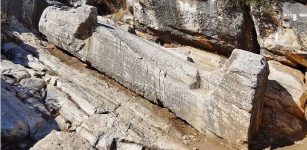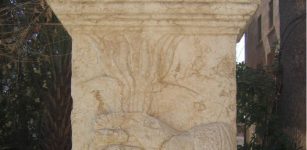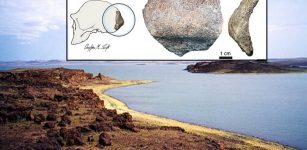Discovery: Massive Gawro Wall Dated To The Antique Age: Was It A Symbolic Or Defensive Structure?
Conny Waters - AncientPages.com - Remnants of a drystone wall, known as the ‘Gawri Wall’ or ‘Gawri Chen Wall’, dated to the Antique Age have been discovered by Iranian archaeologists working along the borders of Serpol Zehab city in Kermanshah province, western Iran.
 Gawri Wall: Ancient stone wall 115-km-long discovered in Western Iran. Image source
Gawri Wall: Ancient stone wall 115-km-long discovered in Western Iran. Image source
The ruined wall that extends along the modern border of Iraq and Iran, and is stretching southward 71 miles from the Bamu Mountains, was built using natural local materials, such as boulders and cobbles, with gypsum mortar surviving in places.
Due to the poor preservation of the wall, archaeologists could only estimate that the wall was four meters wide and ca. three meters high. The wall was constructed with 1 million cubic meters worth of stones, and it has an estimated length of 115 km (71 mi).
In length, the wall is similar to the famous Hadrian’s Wall (73 mi (117 km) long that was constructed across England by the Romans.
In Iran, there is also another huge wall that stretches for almost 200 km and is dotted by a total of 38 forts. This structure is known as Great Wall Of Gorgan.
It is one of the world's most sophisticated frontier walls ever built. It is the longest fort-lined ancient barrier between Central Europe and China. It is also longer than Hadrian’s Wall and the Antonine Wall (the most magnificent structure left by the Romans in Scotland) put together.
Ali Baigi from Tehran University's Archaeology Department said that they are not sure whether the wall was symbolic or built for defensive purposes, as most of the structure is now in ruins, adding that it probably functioned as a border for an ancient empire, writes Daily Sabah.
Still, much job has to be done, but already now, archaeologists believe the structure either belonged to the Parthian Empire, which ruled the region between 247 B.C. and 224 A.D., or to the Sassanid Empire that ruled between 224 A.D. and 651 A.D.
 The remains of the Gawri Wall in the western mountains of Sar Pol-e Zahab; arrows indicate the line of the wall. Image Credit: F. Fatahi.
The remains of the Gawri Wall in the western mountains of Sar Pol-e Zahab; arrows indicate the line of the wall. Image Credit: F. Fatahi.
The archaeological record of the Sar Pol-e Zahab region suggests that the construction of such a massive wall would only have been possible from the Parthian period (third century BC) onwards.
In their paper, researchers write:
"The route of the wall seems to have been determined by the topography of the area, and it frequently crosses mountain ridges, reaching significant heights. We surveyed approximately 250km2 of the Sar Pol-e Zahab region intensively, tracing the line of the wall to where it extended beyond the northern and southern extents of our survey area...
Ceramic finds from along the wall support a construction date during the Parthian or Sasanian period. Regional settlement patterns and the results of excavations reveal that, at this time, the construction of the wall could have been by order of a Parthian or Sasanian king, then implemented by a regional king or member of the nobility in Qaleh Yazdgirdor, or one of the prominent castles in the area.
Parts of the boundary marked by the wall have long represented a border, from the third millennium BC through the Parthian, Sasanian, Ottoman and Qajar periods, up to the present day.
The survey team will continue research in the area to understand more fully the archaeological landscape of this region and the nature of the Gawri Wall.
Reads more in the article "The Gawri Wall: a possible Partho-Sasanian structure in the western foothills of the Zagros Mountains"
Written by Conny Waters - AncientPages.com Staff Writer




















